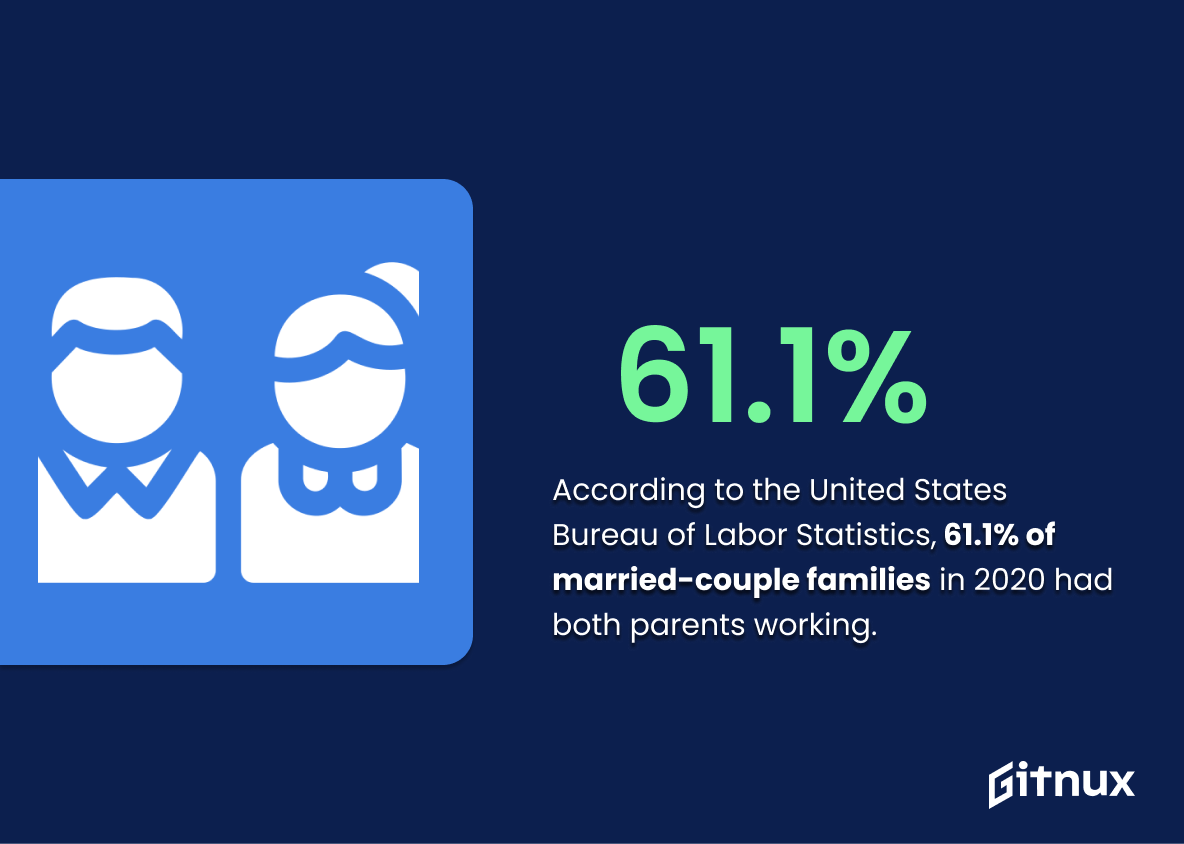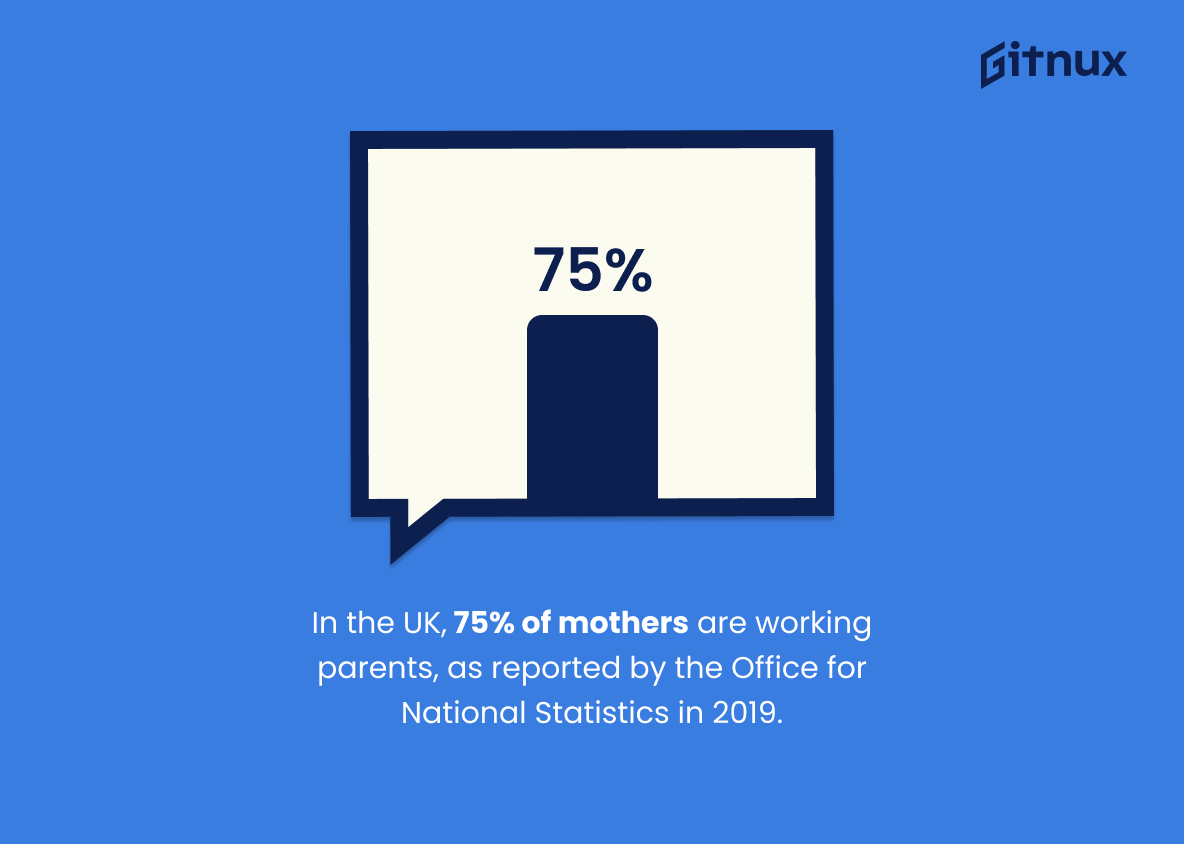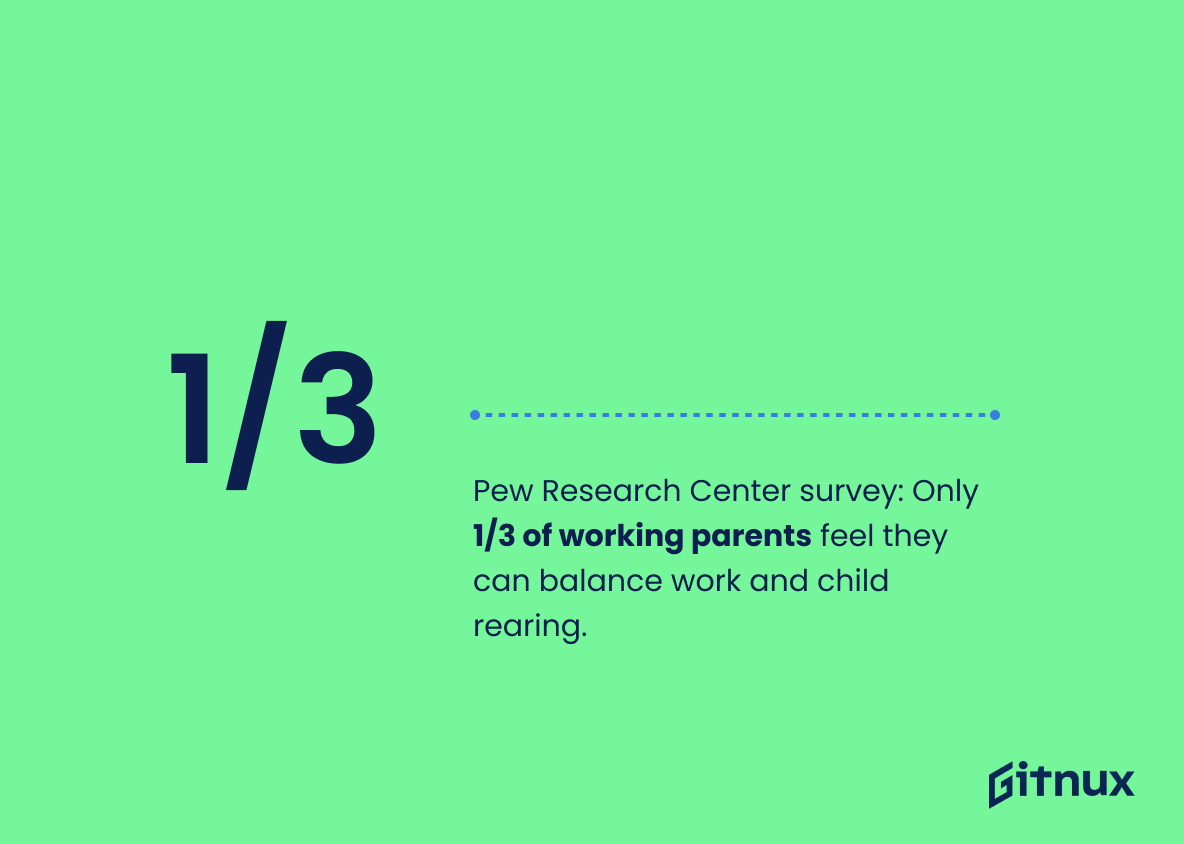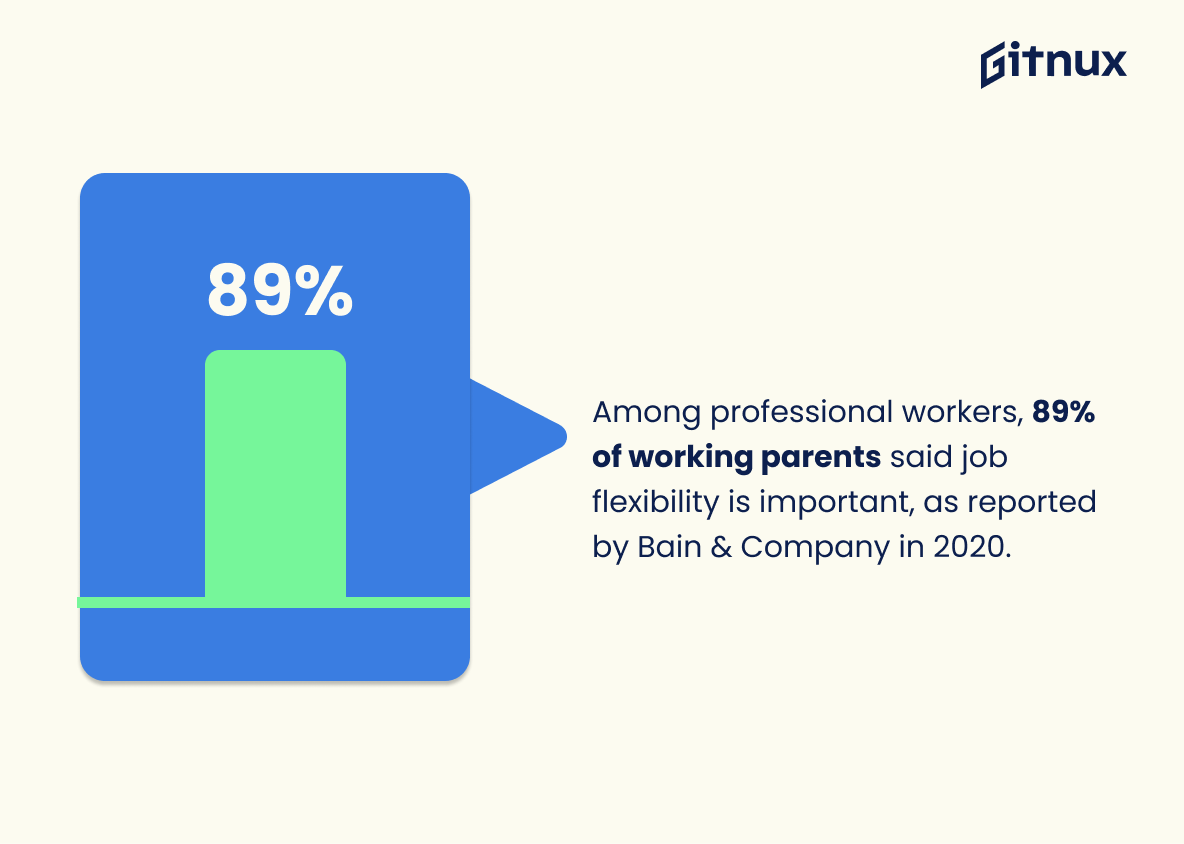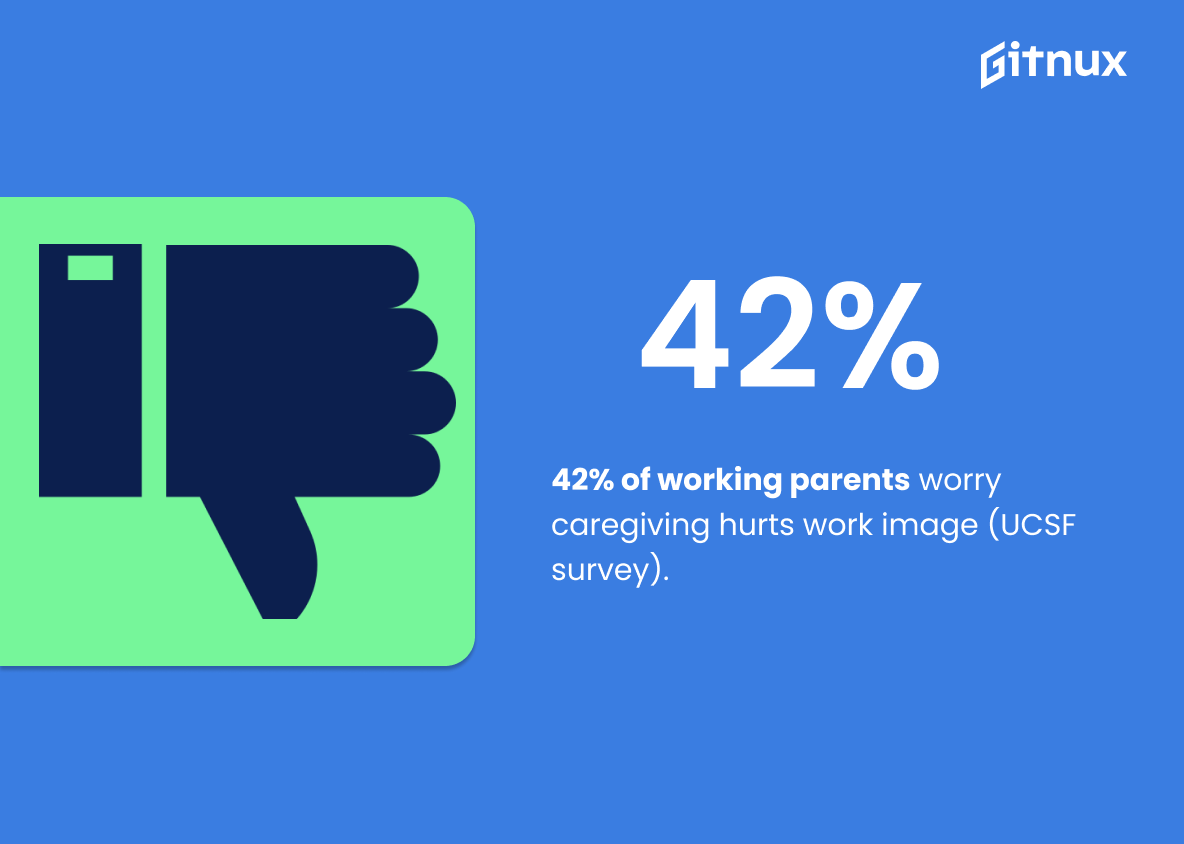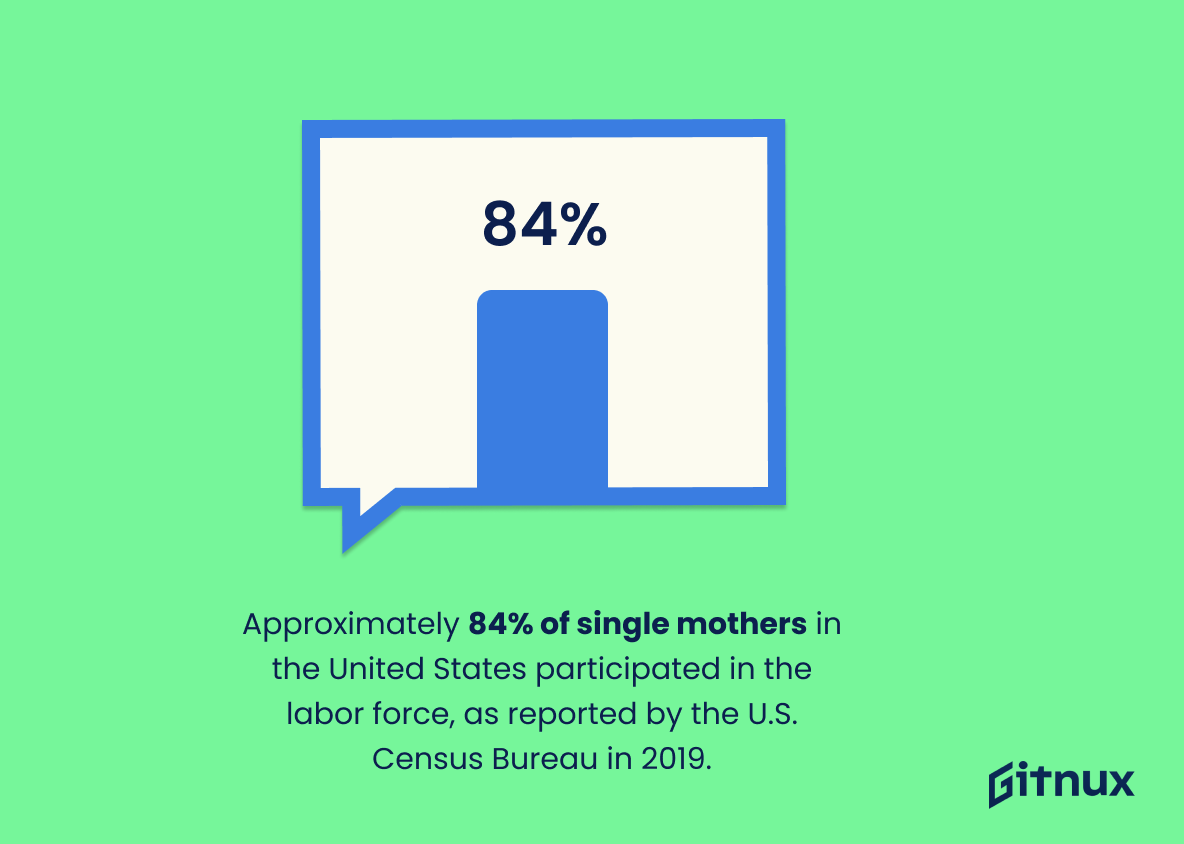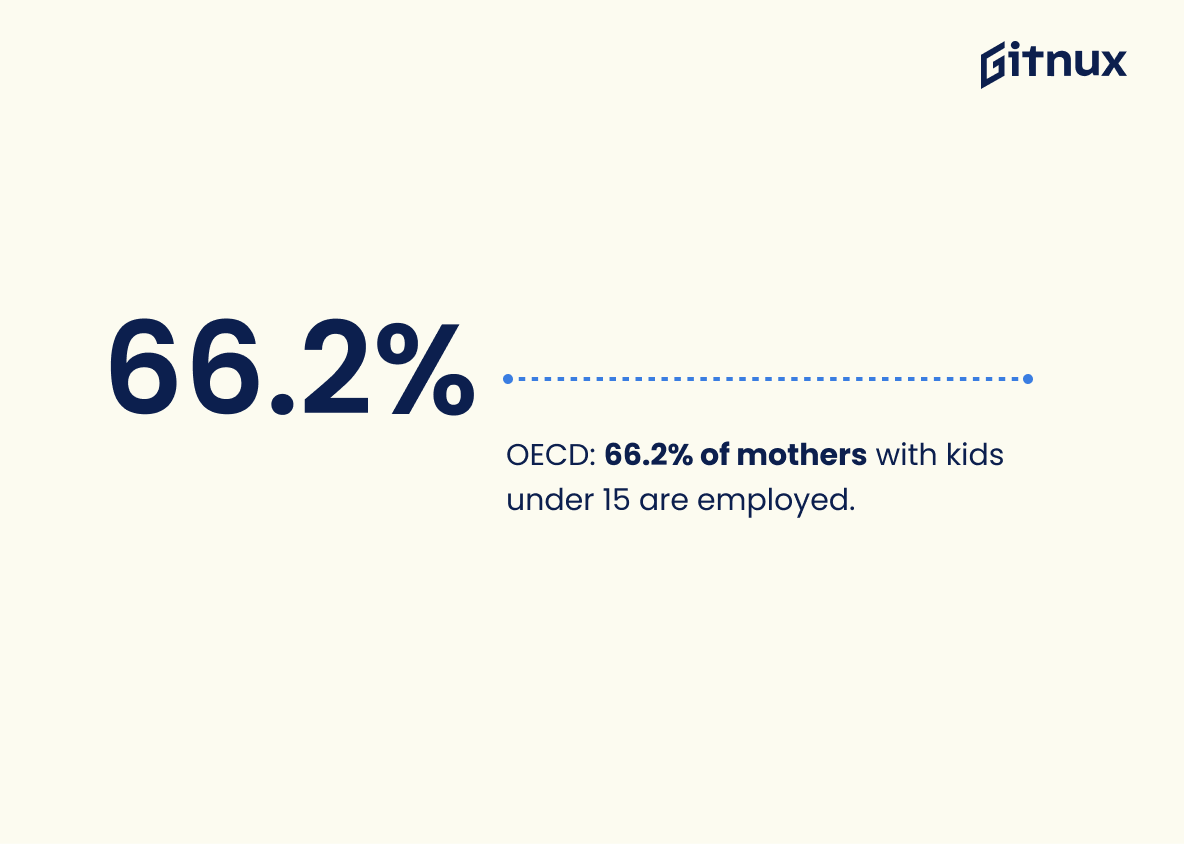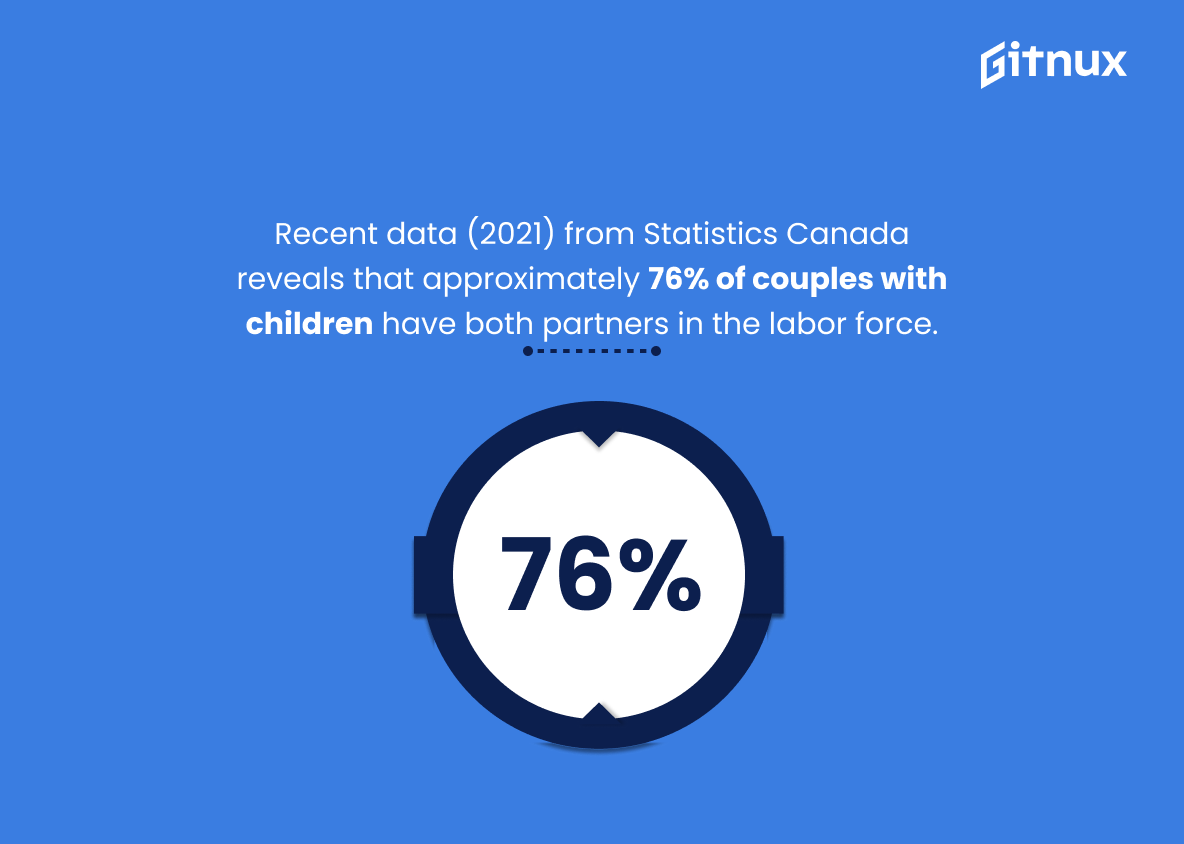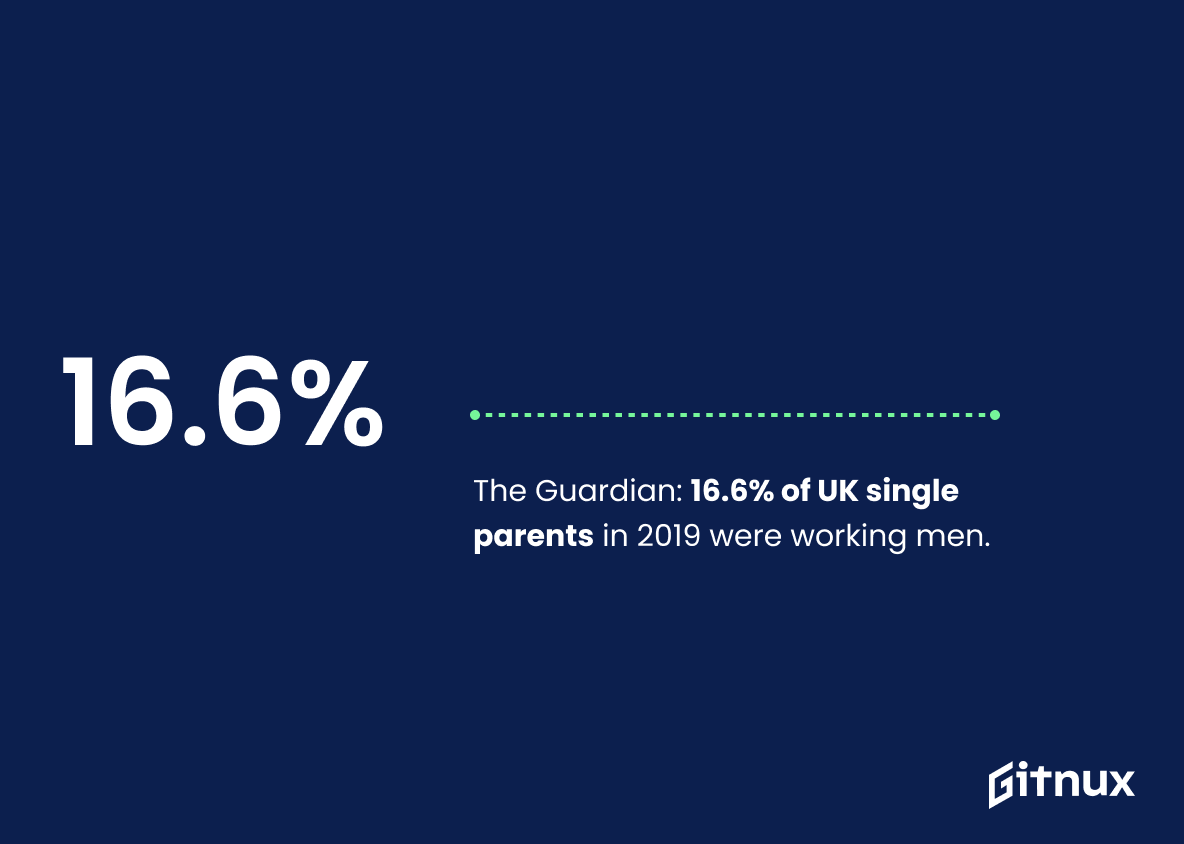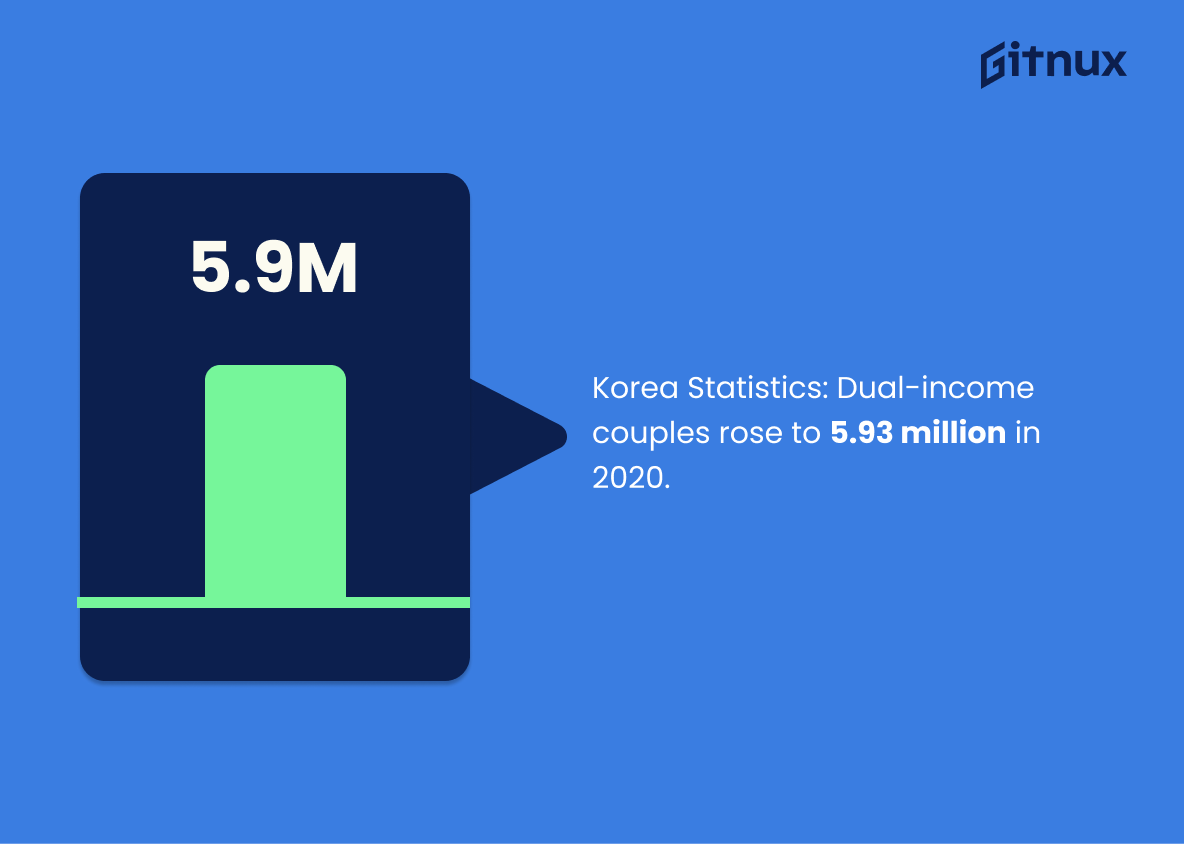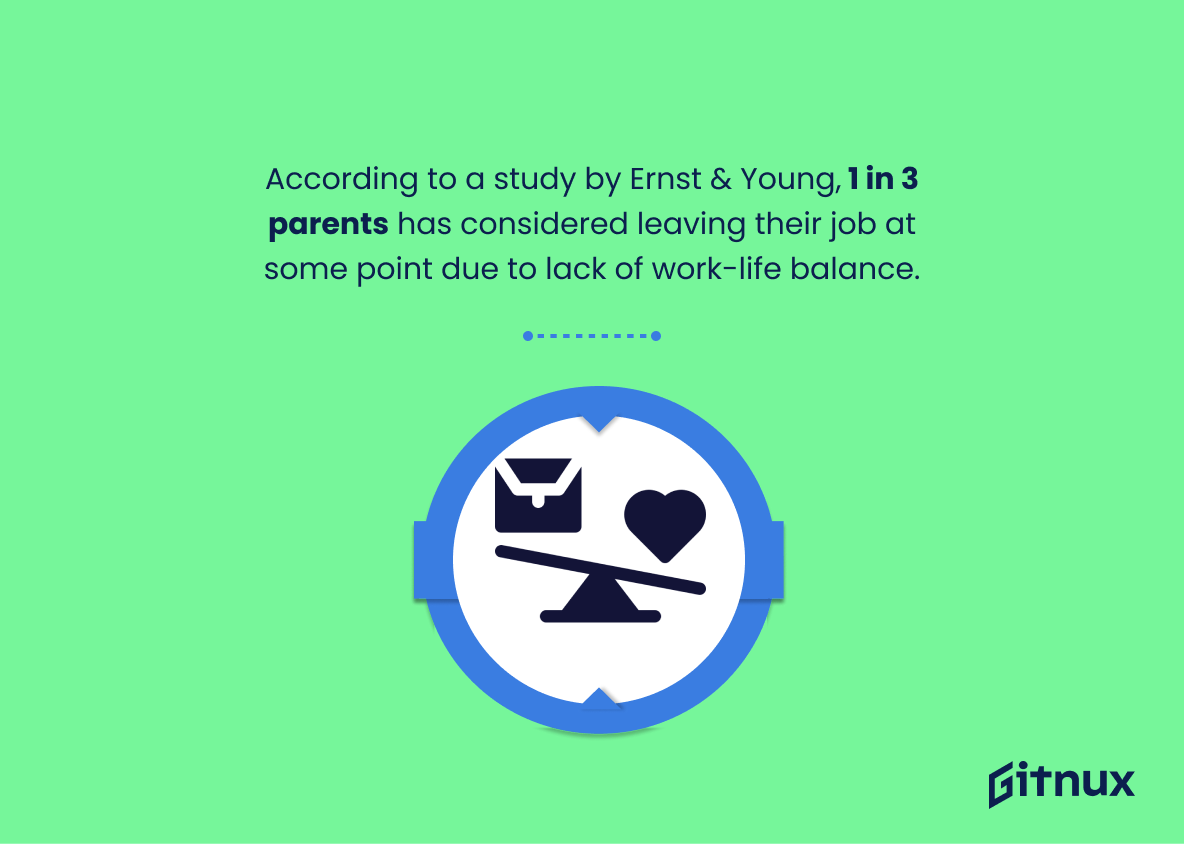As the modern world evolves, so does the dynamic within our households. A significant shift is the rise of households where both parents work. Working parents have become not just a trend but a norm in modern society. Nevertheless, juggling between work and home responsibilities isn’t a walk in the park as it comes with a unique set of challenges and tribulations. This blog takes an in-depth look at this emerging scenario, diving into the hard-hitting statistics of working parents. From labor force participation rates to the balancing act of roles at home and work, this post aims to shed light on the real-world experiences of working parents through numbers that tell the tale. As we delve into this topic, we’ll better understand the landscape of working parents today and the impacts thereof on families and society at large.
The Latest Working Parents Statistics Unveiled
According to the United States Bureau of Labor Statistics, 61.1% of married-couple families in 2020 had both parents working.
Diving into the heart of working parents statistics, an impressive data point catches our eye – the United States Bureau of Labor Statistics indicated that in 2020, 61.1% of married-couple families had both parents earning a paycheck. This is an essential stat that paints a compelling picture of the modern nuclear family, with both parents contributing to the economic stability of the household.
This percentage offers a significant narrative on the dynamics of modern parenting. It’s not just a number but a testament to the evolving societal norms and responsibilities of being a parent, effectively highlighting the shift away from traditional single-income households. Moreover, it underscores how dual-income has become a necessity for many American families due to economic demands, but it also reflects changing gender roles and increased opportunities for women in the workforce.
In essence, this 61.1% mirrors the changing face of the American labor landscape and serves as a reflective tool for understanding the ground realities of working parents. When talking about working parents, it’s a powerful statistic to anchor the conversation and explore the associated challenges, rewards, and trends.
In the UK, 75% of mothers are working parents, as reported by the Office for National Statistics in 2019.
Recall the saying ‘figures never lie’, particularly when reflecting on the reported 75% of UK mothers who are working parents, data provided by the Office for National Statistics in 2019. This significant number allows us to gain a valuable perspective on the evolving dynamics in households across the UK. The figure draws a picture of the modern working mother, juggling career aspirations and motherhood in a demanding societal landscape. This might give rise to discussions about societal shifts, workplace policies, child care support systems and high levels of endurance displayed by these mothers. Consequently, understanding this statistic is paramount for articulating informed views concerning the challenges and triumphs of working parents.
Only about a third of working parents feel they can balance work and child rearing, according to a 2016 survey by Pew Research Center.
The conundrum that lurks in the minds of working parents, ‘Is it actually possible to balance work and child-rearing successfully?’ stealthily unveils itself in this striking 2016 Pew Research Center’s statistic. This fact paints a vivid picture of the tug of war that most working parents are engaged in daily, with only a third of them feeling that they’ve mastered the art of equilibrium. In the grand tapestry of Working Parents Statistics, this thread stands out, compelling us to delve deeper into the various dynamics that working parents grapple with. Understanding this struggle offers an invaluable perspective for devising policies, frameworks, and support systems that are cognizant of the realities and complexities of juggling careers and parenting.
Among professional workers, 89% of working parents said job flexibility is important, as reported by Bain & Company in 2020.
Highlighting Bain & Company’s revelation that 89% of professional working parents classify job flexibility as a substantial work element casts a spotlight on the contemporary work-life balance challenges. It underlines the growing interplay of career responsibilities and familial obligations among modern employees. In our blog post about Working Parents Statistics, this statistic steps off the page as a bold testament to the changing dynamics in family-career interface, illustrating the pressing need for employers to consider flexible work models. It moreover underscores the necessity of up-to-date policies that can cater to this rising professional demographic, thereby optimizing performance, job satisfaction, and talent retention. Furthermore, it sets a conversation tone on the importance of companies recalibrating their organizational structures to accommodate the evolving needs of this relatively significant percentage of the workforce.
According to a 2015 report from the Center for American Progress, 70% of working parents in the U.S. struggle to balance job obligations with family time.
Highlighting this tangible metric elegantly underscores the reality that the majority of American working parents are juggling between professional responsibilities and familial commitments. This precise percentage from a reputable source, the Center for American Progress, vividly paints a picture of the prevalent struggle, thereby lending credence to the blog post’s exploration of the subject matter. The inclusion of this information forces the reader to confront the pressing issue, engendering a deeper understanding of the challenges working parents endure on a daily basis. Further, it provides a launch pad for potential solutions or coping mechanisms that the blog post may be poised to offer. Ultimately, this statistic serves as an empathic thread, connecting readers directly with the dilemmas of work-life balance that many working parents face, compellingly substantiating the blog’s discussion of working parents statistics.
A survey done by the University of California in San Francisco revealed that 42% of working parents fear their work performance is being judged negatively because of their caregiving responsibilities.
In the dynamic world of working parents, this illuminating statistic from the University of California sweetens a compelling narrative about the struggles they face. The convincing figures sing a tale where 42% of these parents are grappling with a lurking fear that their work performance may be undergoing negative scrutiny due their commitment to caregiving roles. This statistic introduces not just mere numbers, but a profound reality faced by working parents, reinforcing the essence of our blog post on Working Parents Statistics. It demands a second thought, an empathetic understanding, while spotlighting the need for a workplace culture that supports rather than criticizes the duality of roles performed by working parents.
Approximately 84% of single mothers in the United States participated in the labor force, as reported by the U.S. Census Bureau in 2019.
Highlighting an intriguing facet of the American labor force, the statistic reveals the resilience and determination of single mothers. From the revelation that approximately 84% of single mothers in the U.S actively participated in the workforce in 2019, as documented by the U.S. Census Bureau, we are met with an image of American tenacity and dedication.
In a blog post delving into Working Parents Statistics, such an intriguing factoid illuminates an often overlooked segment of the working population, raising a curtain on the countless single mothers who juggle the demands of rearing children while simultaneously holding down a job. It paints a vivid portrait of their commitment to providing for their families, despite the tremendous challenges they face, leading us to reevaluate our understanding of the labor market dynamics and work-family balance in the contemporary society.
Moreover, this evidential backbone offers a compelling argument for the development and implementation of policies related to workplace flexibility, childcare support, and work-family integration. Hence, it fuels a vital conversation surrounding economic, societal, and familial supports for working single mothers, imbuing the discussion about Working Parents Statistics with an enriching depth and purposeful vigor.
The Organisation for Economic Co-operation and Development (OECD) reports that roughly 66.2% of mothers with children under the age of 15 are employed.
Diving into the dimension of working parents, the provocative revelation from the Organisation for Economic Co-operation and Development (OECD) sheds light on a compelling facet. It reveals that a considerable 66.2% of mothers with children under 15 are not just cultivating futures at home but also actively contributing to the economic infrastructure. This percent is a powerful reflection of the intertwining roles women adeptly manage, drawing a picture of societal progression and offering profound insights for the purpose of policymaking, hiring strategies, and childcare support systems. In essence, this statistic acts as a litmus test, gauging our society’s capacity to juggle parenthood and professional life and ultimately helps illuminate the path towards equitable workplace policies for the community of dedicated working parents.
The Population Reference Bureau declared that approximately 70% of children live in households where all adults are employed.
In the landscape of working parents statistics, this revelation by the Population Reference Bureau—that around 70% of children reside in households with fully employed adults—casts a dramatic light onto the everyday realities of families. This isn’t just another number, but a reflection of how the modern family functions, with parents juggling multiple roles and responsibilities simultaneously. It highlights the shift from traditional single wage earner households to dual-income ones. Delving deeper, this statistic sheds light on the challenges and opportunities of childcare and youth development in such families. With this knowledge, businesses, policy makers and society at large can more effectively support working parents and their children. These aren’t just facts and figures, they paint a story of the contemporary family, an ever-evolving narrative of parents persisting and striving for the betterment of their children’s future.
Recent data (2021) from Statistics Canada reveals that approximately 76% of couples with children have both partners in the labor force.
Unraveling the threads of this statistic, it becomes instantly clear that it’s the heartbeat in understanding today’s norm of dual-income families. The remarkable figure of 76% of couples with children having both partners laboring paints a vivid picture of the changing societal landscape. This dynamic reflection from Statistics Canada’s 2021 data indicates a shifting balance in household roles and family economic structures, a key focus of our discussion on Working Parents Statistics. It serves as a well-lit beacon, guiding us through our exploration of work-life balance, childcare necessities, and policies affecting working parents.
According to a 2019 U.S. Census Bureau report, nearly 33% of working parents reported using paid child care services.
Appreciating the influence of the given statistic, we find it to be a noteworthy consideration for several reasons. First, it mirrors the socioeconomic dynamics of many families in modern society, where both parents work and, out of necessity, seek paid child care services. As such, the fact that almost a third of working parents reported using these services in 2019 reveals how profound this shift in family structures has become in the United States.
Secondly, it presents an intricate weave in the fabric of labor force participation rates among parents, influencing their productivity and work-life balance. Navigating through this, the statistic highlights a salient and common challenge for working parents — that of securing trustworthy and affordable child care.
Furthermore, it gives a glimpse into the market share and potential growth of the childcare industry, offering crucial insights for economists and policymakers. And ultimately, shedding light on the evolving parental roles in a working world, this statistic forms a pivotal facet of the terrain mapped out by Working Parents Statistics.
The Australian Bureau of Statistics found that 63% of parents with young children work.
Painting the picture of modern parenthood, the startling statistic from the Australian Bureau of Statistics – 63% of parents with young children working – presents itself as a crucial component to the narrative. Not just a number, this statistic is a reflection of a society where balancing childcare with professional obligations has become a norm. It provides concrete evidence for discussions about the challenges and triumphs faced by working parents, contributing valuable insight to the dialogue around enhancing support systems for this group. This statistic, therefore, serves as a compass, guiding readers through the diverse landscape of working parents’ realities.
In 2019, around 16.6% of all single parents were men in the UK, a large proportion of whom are working parents, as reported by The Guardian.
Highlighting the figure of 16.6% of single parents in the UK being men in 2019, as reported by The Guardian, offers a fresh perspective on the evolving dynamics of families in contemporary society. This statistic defies traditional gender norms, underscoring the growing phenomenon of single fathers taking on the dual role of breadwinners and caregivers. In a blog post about Working Parents Statistics, such a fact provides readers with a broader understanding of the diversification in family structures, consequently highlighting issues and policies that need to be empathetically addressed for working single fathers, and challenging assumptions woven into the fabric of societal narratives. Moreover, acknowledging this trend not only reaffirms our cognizance of the changes in parenting paradigms, but also fortifies the discussion on the need for equitable support systems for all working parents.
The number of dual-earning couples in South Korea has steadily risen over the past decade reaching 5.93 million in 2020, according to Korea Statistics.
Shining a light on the transformative shift in traditional family roles, this illuminating statistic brings into focus a key trend in South Korea’s societal fabric – the rise in dual-earning couples. In the framework of the blog post about Working Parents Statistics, this figure weaves a nuanced tale of economic necessity and social evolution, underscored by the evolving gender roles and work-life balance.
This noteworthy increase to 5.93 million dual-earning couples in South Korea in 2020 starkly unveils the gradually changing landscape of parenthood and workforce participation in the country. It is a fascinating reflection of the growing economic contribution of both parents in a household, signaling increased female labor force participation as well as highlighting the emergence of shared parenting responsibilities.
In essence, such a powerful trend deepens our understanding of contemporary parenting, financial pressures, and societal changes. It helps paint a fuller picture of modern-day working parents, where both parents share the economic burden and navigate the challenging waters of balancing professional aspirations and family commitments.
According to a study by Ernst & Young, 1 in 3 parents has considered leaving their job at some point due to lack of work-life balance.
Drawing the curtain back on the delicate balancing act of modern working parents, this crucial statistic folded into Ernst & Young’s research delivers a powerful narrative punch. Unearthed in a sea of data, the revelation that 1 in 3 parents has mulled over quitting their job due to an elusive work-life balance forms a silent uproar.
These numbers throw light on the impending crossroads where the corporate world and family life collide. They underscore the escalating friction between professional responsibilities and familial duties that parents navigate daily. In essence, they breathe life into a critical dialogue regarding the necessity for restructuring corporate cultures to facilitate balanced lives.
In the blog post’s context on Working Parents Statistics, this statistic forms a masterstroke, succinctly epitomizing the juggling act working parents deal with. By shedding light on this often unspoken struggle, it serves as a wake-up call for companies, urging them to reconsider their policies and shift towards a more family-friendly approach.
Data from the Pew Research Centre in 2019 shows that rather than subtracting from work hours to care for family, U.S. parents are more likely to add on work hours.
Highlighting such an intriguing statistic from the Pew Research Centre provides a valuable lens through which we can view the multi-dimensional world of working parents. It accentuates the reality of working parents in the U.S.—a group that is not only juggling the responsibilities of parenthood but also striving to succeed in their chosen careers. This dynamic illustrates the sheer effort and dedication exhibited by these parent-workers, painting a picture of individuals who are willing to extend their work hours, rather than compromising them. This finding provides a rich vein of insight that challenges some of the common narratives around work-life balance, suggesting that the path walked by working parents is not a zero-sum game between family care and professional obligations. Instead, it redefines the concept of dedication, commitment, and the constant tug-of-war between familial and professional roles in today’s fast-paced society.
Research from Boston College found that 60% of working parents felt “conflict” between work obligations and the time they want to spend with their families.
Highlighting the Boston College research which identified a significant 60% of working parents experiencing “conflict” between their work obligations and family time fundamentally lays bare one of the profound struggles faced by this demographic. In the landscape of working parent statistics, this insight serves as a compelling testament to the push-and-pull dynamic between professional responsibilities and familial duties. It offers a stark portrayal of how modern work cultures may impinge on personal life, illuminating an urgent issue that requires societal and organisational attention. Moreover, this statistical evidence can fuel the dialogue surrounding flexible employment structures and work-life balance, paving the way towards innovative interventions that honour both vocational pursuits and parental obligations.
A 2015 report from the Federal Reserve Bank of St. Louis suggested that mothers are more productive employees than their childless peers for at least 30 years of their career.
The vivid landscape of Working Parents Statistics gets an intriguing shade with this 2015 finding from the Federal Reserve Bank of St. Louis. It nudges us to reconsider preconceived notions about working mothers. Not only do they juggle the office and home, but they emerge as more productive employees than their childless peers, defying all stereotyped expectations. This statistic resonates for a good three decades of their careers, adding a significant commentary on the long-term impact of parenting on professional productivity. This might encourage employers to reconsider their policies towards working mothers, seeing them not as potential liabilities, but as assets. Moreover, it could empower working mothers themselves, dispelling any self-doubts about their professional capabilities vis-a-vis their childless counterparts. This statistic thus adds an impactful layer to the narrative on working parents, enriching our understanding of work-life dynamics.
An American Psychological Association survey revealed that 25% of working parents experience high levels of stress due to balancing work and family life.
Employing this vital statistic, which illustrates that a quarter of working parents surveyed by the American Psychological Association experience high stress levels due to juggling work and family life, draws immediate attention to the precarious tightrope that working parents walk every day. This number serves not only as a clarion call for understanding and empathy, but also demands a deeper probe into workplace policies, support systems, and societal norms. Furthermore, this statistic punctuates the narrative of our blog post on Working Parents Statistics with a poignant view of the human toll behind the data, enhancing the depth and comprehensiveness of our discourses.
A report by the National Survey of Children’s Health states that 50% of working parents have missed work due to child’s sickness in the USA.
Shedding light on the finding from the National Survey of Children’s Health, we unearth a challenging reality tethering the lives of working parents: a full half of them reportedly had to hit pause on their professional duties and missed work because of their child’s ailment. Within the context of Working Parents Statistics, this piece of data uncovers a substantial intersection between parental roles and professional commitments. It is a wake-up call to industries of the necessity for more lenient policies and work-flexibility to cater to parental responsibilities, thereby fostering a healthier work environment. Furthermore, it illuminates the need for robust child healthcare systems and the enormous economic implications that may result from a lack of such. This statistic is a linchpin not only for understanding the struggles of working parents but also in catalyzing a shift towards more supportive professional and care systems.
Conclusion
The valuable insights drafted from the working parents’ statistics highlight the wide spectrum of challenges, triumphs, and dynamics that working parents encounter daily. Their efforts contribute significantly to both the economy and the molding of the next generation. It also underscores the necessity for more flexible work practices, affordable childcare, and understanding employers. In order for a true societal progression, embracing and supporting working parents should be a priority. With continuous analyses, legislation, and awareness, strides can be taken to elevate the experiences and lives of working parents. The statistics are not just numbers, but narratives of resilience, determination, and parenity.
References
0. – https://www.www.apa.org
1. – https://www.www.ons.gov.uk
2. – https://www.www150.statcan.gc.ca
3. – https://www.www.bain.com
4. – https://www.www.prb.org
5. – https://www.www.bc.edu
6. – https://www.pubmed.ncbi.nlm.nih.gov
7. – https://www.www.oecd-ilibrary.org
8. – https://www.www.childhealthdata.org
9. – https://www.www.theguardian.com
10. – https://www.www.abs.gov.au
11. – https://www.kostat.go.kr
12. – https://www.www.ey.com
13. – https://www.www.bls.gov
14. – https://www.www.pewresearch.org
15. – https://www.www.americanprogress.org
16. – https://www.www.census.gov
17. – https://www.www.stlouisfed.org
